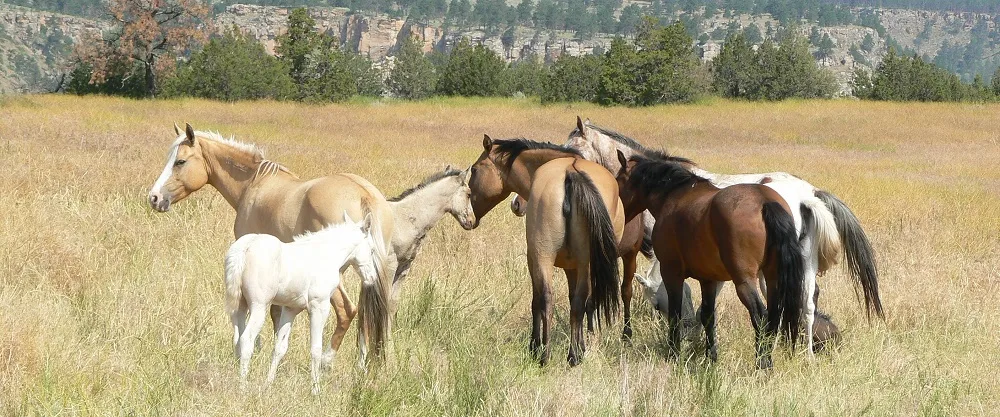The South is home to diverse landscapes, from rolling hills to vast coastal plains, and some of the most iconic wildlife of the region is the wild horse.
These majestic animals have long been a symbol of freedom, resilience, and untamed nature. While many places across the U.S. have seen the decline of wild horse populations, there are still a few spots in the South where these magnificent creatures roam freely. If you’re looking to witness the beauty of wild horses, here are four great places to visit in the South where you can still see them in their natural habitat.
1. Assateague Island, Virginia and Maryland
Assateague Island, which stretches across the Virginia-Maryland border, is perhaps one of the most famous places to see wild horses. The island is home to the Assateague Island National Seashore, a protected area that shelters these iconic wild ponies. Known for their distinctive appearance, the Assateague horses are smaller than typical horses but are equally hardy, surviving in the island’s harsh environment.
The horses here are part of a long-standing tradition, dating back to the 17th century, when it’s believed they swam ashore from a shipwreck. Today, they are cared for by the National Park Service and the Chincoteague Volunteer Fire Company. Visitors can enjoy the sight of these wild ponies grazing along the beach or in the salt marshes. While it is essential to maintain a safe distance, the ponies are often spotted near the park’s trails or while driving along the scenic route.
2. Cumberland Island, Georgia
Cumberland Island, located off the coast of Georgia, is another southern gem where wild horses still roam. This national seashore is one of the best-preserved barrier islands in the U.S., boasting pristine beaches, dense forests, and marshlands. It is also home to a herd of wild horses that have inhabited the island for centuries.
The horses on Cumberland Island are thought to be descendants of Spanish horses brought to the island by early explorers in the 1500s. These wild horses are known for their impressive stamina and adaptability to the island’s challenging environment. The best way to spot them is by taking a guided tour or walking along the island’s trails. While you’re there, you might also spot other wildlife like armadillos, wild turkeys, and alligators, making it a great location for nature lovers.
3. Outer Banks, North Carolina
The Outer Banks of North Carolina are renowned for their windswept beaches and scenic beauty, but they also offer a unique opportunity to see wild horses. The wild horses of the Outer Banks are most often found in the Currituck Outer Banks and the Shackleford Banks. These horses are believed to have descended from Spanish mustangs that arrived on the islands centuries ago.
The wild horses of the Outer Banks are a protected species, and their numbers have been carefully monitored over the years. While they primarily graze in secluded areas, visitors can often spot them along the beaches or in the sand dunes, especially in the early morning or late afternoon when the temperatures are cooler. The Currituck National Wildlife Refuge offers guided tours where visitors can learn about the history and conservation efforts surrounding these wild horses.
4. Grandfather Mountain, North Carolina
Though not as widely known as the other locations, Grandfather Mountain in North Carolina has a small herd of wild horses living in the high-altitude meadows. These horses are an anomaly in the mountainous environment, thriving in the cool, high elevations that offer both challenges and rewards. The horses on Grandfather Mountain are thought to have arrived there in the early 1900s, brought by early settlers who wanted to establish a hardy, mountain-bred horse population.
Today, these wild horses are part of the Grandfather Mountain Stewardship Foundation’s efforts to preserve the wildlife and natural beauty of the area. While the herd isn’t as large as those on the coasts, the breathtaking views of the Blue Ridge Mountains make for a unique backdrop to spotting wild horses. The area around the Grandfather Mountain Nature Museum provides great opportunities for hiking and wildlife viewing, and the horses can often be seen grazing in the meadows or along the hiking trails.
Final Thoughts
Whether you’re hiking the trails of Cumberland Island, relaxing on the beaches of Assateague, or exploring the dunes of the Outer Banks, these four locations offer a rare chance to see wild horses in their natural environment. These animals are not only a symbol of the American South’s untamed beauty but also an important part of its history and ecosystem. When you visit, remember to respect their space and appreciate the unique way of life they represent.
If you ever get the chance, these destinations will provide an unforgettable experience that allows you to connect with nature and witness the beauty of wild horses in the South.




